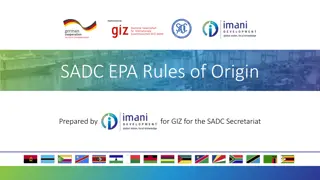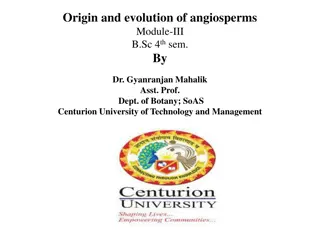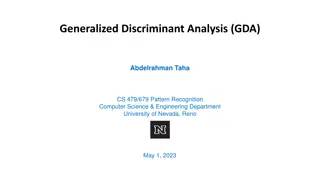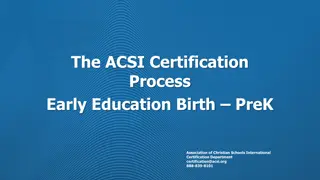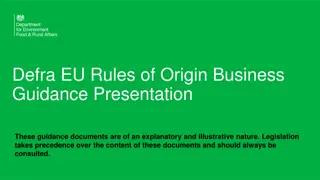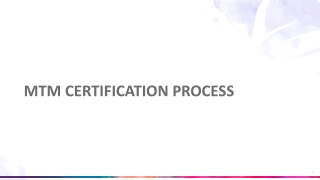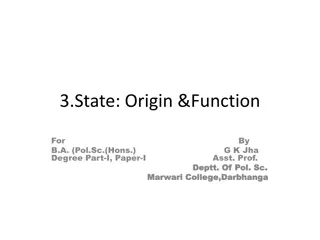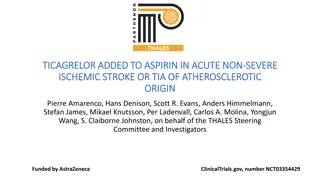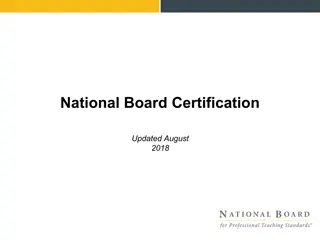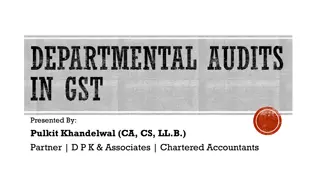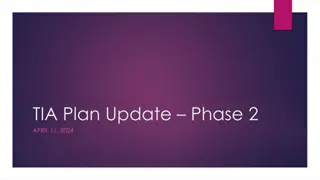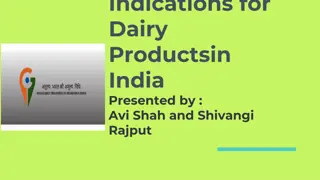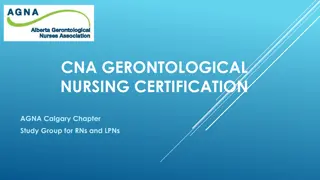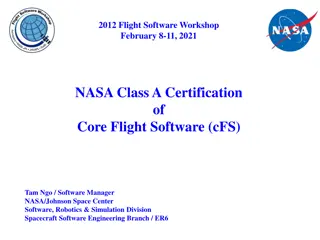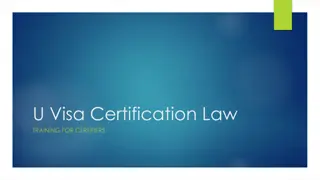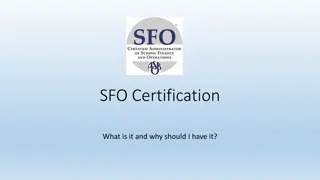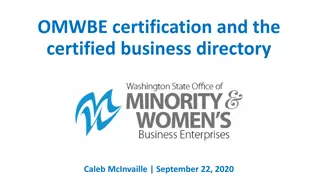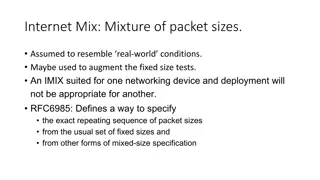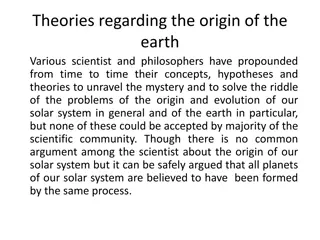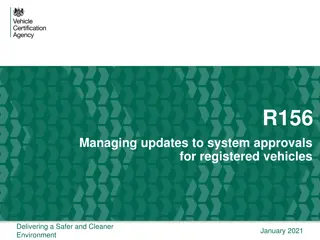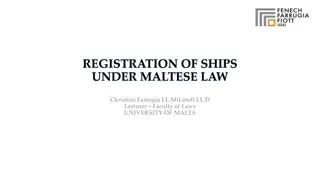Overview of Registered Exporter System (REX) for Origin Certification under Generalized System of Preferences (GSP) for EU
REX is a self-certification system allowing registered exporters to declare the origin of goods. This system simplifies the process by enabling exporters to issue a Statement on Origin (SOO) themselves. Eligible entities in Pakistan can register under REX, ensuring compliance with EU Customs Regulations. The transition to REX ensures exporters take responsibility for the accuracy of origin statements, impacting GSP benefits. Detailed guidelines and requirements are provided for registration and ongoing compliance.
Download Presentation

Please find below an Image/Link to download the presentation.
The content on the website is provided AS IS for your information and personal use only. It may not be sold, licensed, or shared on other websites without obtaining consent from the author. Download presentation by click this link. If you encounter any issues during the download, it is possible that the publisher has removed the file from their server.
E N D
Presentation Transcript
Registered Exporter System (REX) For ORIGIN CERTIFICATION Generalized System of Preferences (GSP) For EU By Kamal Shahryar 1
Presentation Outline 1. REX Introduction 2. Eligibility for Registration Under REX 3. How to Become a Registered Exporter? 3A. Completing REX Application Form 3B. Registration to REX by TDAP 4. Making Out Statement on Origin (SOO) 5. Control of Registered Exporters & Goods Origin 6. Publication of Regtd. Exporters Data on EU Website 7. Why to Register Early Under REX? 8. Trade Agreements Increasing Constraints 9. Things to Manage as a REX Exporter 10. TDAP Assistance on Rules of Origin 2
1. REX - Introduction System for self-certification of origin by registered exporters as self declaration(instead of COO on Form-A thru TDAP). Exporters make out Statement on Origin (SOO) on a Commercial Document that can identify exported products, e.g.: Invoice, or Any other Commercial Document Rules of Origin (ROO) remain unchanged under REX Only the Origin Certification System changes 3
REX Introduction (Contd.) ROO are laid down in EU Custom s Regulations: Delegated Regulation (EU) No 2015/2446, and Implementing Regulation (EU) No 2015/2447 Registration of an Exporter under REX is a one time formality, up-dations will continue during validity of Registration. After Regn. exporter issues SOO (COO discontinued). Pakistan to complete switchover to REX by Dec 2017 (or June 2018) when COO issuance by TDAP ends. For details: Refer REX Operational Guidance Document on TDAP website. 4
REX Introduction (Contd.) Basic difference between REX and existing EU-GSP origin certification system: 1. COO issued by exporter himself rather than a govt body. 2. Only exporters with REX regn. eligible for GSP concession. (exporter directly responsible & accountable for COO quality). CONCLUSIONS: Under existing system: Govt. body (not the exporter) is responsible for quality of the COO. Moreover, under normal conditions GSP is not withdrawn from an individual exporter as a routine. Under REX: Exporter directly responsible for SOO quality. Incorrect SOO may lead to his REX revocation and withdrawal of GSP benefit LESSON: REX system requires exporters to be very careful in: (1) Observing the GSP ROOs (to achieve originating status of products), (2) Issuing correct SOOs, and (3) Maintaining evidences/ documentation as proof of originating status 5
2. Eligibility for Registration Under REX a. Any exporter, manufacturer or trader of originating goods, permanently established in Pakistan or having headquarters in Pakistan* can be registered under REX if he holds evidence of the origin of the products he intends to export (*Business NTN & SECP Registration docs) b.Should be a reliable, established, and functional manufacturer/ trader not subject to bankruptcy proceedings or in arrears of customs duties & taxes. c. Should be able to submit at TDAP s request, all appropriate documents proving the originating status of the products concerned. d.Should accept periodic monitoring & verification by TDAP, of his accounting records and manufacturing processes e. Should keep for three years (starting end of calendar year of SOO issue) copies of SOOs made by him along with relevant supporting docs. f. Should assume the entire responsibility for use of the registration number. g. Should agree to inform TDAP of any alterations in his registration data. ( a to g to be looked into by TDAP while registering an exporter into REX) 6
3. How to Become a Registered Exporter? REX Application Form to be completed on-line using pre- application process. Manual Application Form: Acceptable only in exceptional cases/ major constraints (risks: registration issues/ delays due to incomplete information, options/ flexibility N/A, entry errors). Exporters to print completed Form (filled online), then: 1. Sign the completed Form at all relevant places 2. Attach attested copies of Co s. NTN and Registration Certificates (SECP). 3. Get the Form endorsed by concerned Trade Body. 4. Send to TDAP, HQ, Karachi (GSP Sectn). If exporter gives it to local TDAP office, they will send Forms same day to TDAP, HQ (by courier). 7
3A. Completing REX Application Form Simple steps for Registration to REX System Document on TDAP website. TDAP Offices can assist. Access REX Pre-application Form at Europa website : https://customs.ec.europa.eu/rex-pa-ui/#/create-preapplication/ Completing the REX Form Online: Box 1: "Exporter information appln. language, business name, address, tel., fax, email, & TIN (Trader Identification No.) TIN: PK + Co s. NTN (e.g. PK26927584, no empty spaces or dashes) Box 2: Contact details of Exporter's Contact Person(s) Contact person name, address, tel. no., fax, email address. Multiple contact persons can be entered using [Add] button Box 3: Exporter's business", i.e. if his main activity is production, trading, or both (tick one or both boxes) 8
Completing REX Application Form (Contd.) Box 4: Provide "indicative description of goods Enter 2 or 4 digit HS Code (Chapter, Heading) Select corresponding description from choices (or reverse) Additional products can be added using [Add] button Box 5: Undertakings to be given by exporter (already given). Enter: place, name, designation Box 6: exporter s Consent to publication of his data on EU website. [Tick]; then Enter: place, name, designation Validate: type text from image into box . Click [proceed] to complete Form. Click [Print] to print Form (as pdf doc in your downloads ) Sign Printed Form: at two places (Undertakings, Consent) Specimen Appln Form completed online (Annex-3, REX Guide - website). Data entry by Exporter completes here. 9
3B. Registration to REX by TDAP If exporter fills REX Form manually, TDAP will have to re-enter all the data online from it (into the REX Authorization Form ). In case REX Form filled thru Pre-Application Process, TDAP will retrieve data by entering TIN in REX Authorization screen. Box 7 of REX Form: For official use (to be completed by TDAP): Registration Number: PKREX+TIN, (e.g. PKREXPK26927584) National Authority Ref. Number: PK000001 Date of Registration: Enter current date (may select from calendar. No future date is allowed) Date from which Registration is valid: Equal or before the date of Registration, can t be later (can be selected from calendar) Save, then print the Form. Have it signed and TDAP seal affixed. 10
Registration to REX by TDAP (Contd.) Exporter will be registered once his REX Form data is verified, and completely & correctly entered into REX database by TDAP. TDAP will promptly notify exporter of his registration (REX No.) by email, sending original REX form by courier (TDAP signed & stamped). Copy will be retained in TDAP record. Upon registration exporter will forthwith start issuing SOO (TDAP will no more issue COO to the exporter internal system among TDAP Offices to ensure this). Exporter should promptly apply to TDAP for any modification in his data. TDAP will inform exporter after making modification(s). Validity of REX registration is not limited in time (unless revoked by TDAP for any reason, like: Exporter s own request; Invalid SOO issuance; failure to meet REX conditions, or if exporter ceases to exist). 11
4. Making Out Statement on Origin (SOO) Exporter making SOO should be able to: a. declare and prove origin of goods, and b. reply to request for verifications. If exporter making SOO is not the producer, then he should have all necessary documents/ supplier's declarations enabling him do (a) & (b) above. Text of the SOO (Refer: Annex-2, REX Operational Guide ) The exporter Name [REX no.; additional details if replacement SOO ] of the products covered by this document declares that, except where otherwise clearly indicated, these products are of Pakistan preferential origin according to rules of origin of the Generalized System of Preferences of the European Union and that the origin criterion met is ( P; or W+HS Heading, e.g. W 9618 ) . 12
Making Out Statement on Origin (SOO) Contd. SOO is issued by typing, printing or stamping text on the Invoice or another Commercial Document (e.g. accompanying Delivery Note, Pro-forma Invoice, or Packing List) that clearly: Identifies the Registered Exporter, Describes consignment s goods in detail for their identification & origin Identifies non-originating products; e.g. by: indicating this in brackets behind every product line, or placing goods on Invoice under separate headings of originating goods and non-originating goods , or numbering the positions consecutively and indicating which numbers are originating and non originating goods. No handwritten signature of exporter is required on SOO. 13
Making Out Statement on Origin (SOO) Contd. If value of originating products in the consignment is below Eur 6,000 then any exporter, registered or not, can make out an SOO. Stating REX no. is mandatory if Eur 6,000 threshold is exceeded. SOO on a label (permanently affixed to a commercial document) is only permitted if there is no doubt that the label has been affixed by the registered exporter. SOO may be made on third parties commercial document if the commercial documents clearly identify the registered exporter. 14
Making Out Statement on Origin (SOO) Contd. A transport document (e.g. bill of lading or airway bill) is not considered a commercial document for SOO purposes as it is issued by the carrier or forwarding agency. Hence not fit for SOO issuance. SOO may be submitted on a separate sheet of the commercial document, only if this sheet is an obvious part of this document. If commercial document contains several pages, each page must be numbered, the total number of pages must be mentioned. SOO shall be valid for 12 months from the date of its making by the exporter. SOO may be made after exportation( retrospective statement ), it will be admitted in the EU if presented in the member state for release of goods no longer than two years after the export. 15
5. Control of Registered Exporters & Goods Origin TDAP s Responsibilities Under the REX System: 1. To carry out checks & verifications of the originating status of products mentioned on SOO, in accordance with the ROO: i. Upon request of the importing country for verification of SOOs. ii. TDAP s procedure: choice of exporters/ SOOs & frequency of checks would depend on risk analysis (products, sectors, and destinations). [Note: For 1(ii), exporters will provide to TDAP copies of all SOOs made by them along with a Summary Statement on a monthly basis by 15th of a month. 2.TDAP will carry checks based on exporter s documents, or by inspections at exporter's & their suppliers premises through: i. Checking SOOs for materials and products [in compliance of 1(i)] ii. Checking supplier s declarations, for goods/ materials purchased from other companies. iii. Comparing exporter's trade flows (materials/ products) with relevant accounting record. 16
Control of Registered Exporters & Goods Origin (Contd.) 3. TDAP to regularly monitor registration data of exporters to ensure that it s still up-to-date (the exporter exists, the address is unchanged, the contact person is valid). 4. If irregularities found, TDAP may take different measures: i. For discrepancies not affecting proper functioning of the registration (e.g. registered exporter issues SOO for a product not in his list of products) asking registered exporter seek an update to ensure future compliance. ii. Issue progressive warnings to the registered exporter pointing out shortcomings in cases of minor importance before taking any extreme step. iii. Revoking the registered exporter for incorrect SOO issuance. 5. REX System data is published at: https://ec.europa.eu/taxation_customs/index_en 17
Control of Registered Exporters & Goods Origin (Contd.) Obligations of Exporters under the REX System: 1. Provide copies of SOOs made & statement to TDAP (monthly) 2. Keep available: All evidence relating to the materials used in the manufacture All customs documentation relating to the materials used in the manufacture Records of: (i) the SOO they made out (ii) their originating and non-originating materials, production and stock accounts (for at least 3 years from the end of the calendar year in which the SOO was made out, or longer if required by national law) 18
6. Publication of Registered Exporters Data on EU Website If the exporter consents (box 6 - Application Form), following data is made public on Internet: TIN number and REX number of the registered exporter Name of the registered exporter Address of the place where the registered exporter is established Contact details of the registered exporter Indicative description of the goods which qualify for preferential treatment Date from which the registration is valid Date of the revocation (if applicable) Information whether the registration applies to Switzerland/ Norway (Note: Exporter s data displayed on Internet if consent not given) 19
7. Why to Register Early Under REX? Weak origin certification puts the EU buyer under direct risk. Buyers under REX have greater responsibility for ensuring correct origin certification (higher comfort due to enhanced role). EU Regulators & Customs have much greater faith in origin certification under REX (so lesser verification requests). Thus, all other things being same, buyer may prefer to source from REX countries & exporters: Pakistan is in first batch of REX (2017=38/77, 2018=17, 2019=22) - Edge Pak. Cos. getting early REX will have an edge (among Pak & batch-1 countries) Evidence: Buyers already pursuing Pakistani exporters for REX nos. REX allows more efficient origin certification (quicker, simpler) 20
8. Trade Agreements Increasing Constraints Preferential Trade Agreements (PTAs, FTAs, GSPs, etc.) grant preferential market access. Benefits from such agreements depend on following key factors: I. Extent of Tariff Concession: Depth of tariff concessions (extent of tariff eliminations & tariff reductions). Spread of tariff concessions (% of tariff lines covered) Timelines/ phasing for tariff concessions II. Structure of Rules of Origin: Terms for grant of originating status (mainly for substantially worked or processed category) (1) Heading/ Sub-Heading Change; (2) Value Addition (limit non-originating; mat. (3) Specific Processes (specific processes, transformation level) Additional: (a) Insufficient Working/Processing; (b) Tolerances III. Exporter Registration Requirement & Terms/ Documentation: Other Restrictive Aspects: Extent/ frequency of monitoring & verification, documentation, timeframes, NTMs/ NTBs/ TBTs/ SPS/ Quotas 21
9. Things to Manage as a REX Exporter Adequate & correct understanding on EU-GSP ROO in respect of own products, raw/ sub-materials, and processes. Adopt possible cost effective measures to meet ROO for product(s) to qualify as Originating , e.g.: Sourcing from other domestic suppliers Benefiting from Cumulation Provisions (regional, bilateral, etc.) Vertical integration, where feasible (additional stages in-house) 22
Things to Manage as a REX Exporter (Contd.) Issue correct SOOs to: Provide adequate comfort to buyer(s), local monitoring authority (TDAP) Eliminate any REX revocation Threat (for incorrect SOO) Maintain simple/ cost effective systems for meeting documentation/ traceability requirements (w.r.t monitoring & verification). Documentation systems/ requirements will depend on: ROO applicable & originating criteria w.r.t: Nature of products, in-house processing, nature & sourcing of outside materials, etc. 23
10. TDAP Assistance on Rules of Origin (ROO) Assistance from TDAP is available for assessing originating status of exportable products w.r.t ROO of EU-GSP. Such assessment requires information on following parameters: HS code and description of the finished product and its ex-factory price per unit. HS Codes and descriptions for each of the non-originating (imported) materials along with the import value (cost to exporter) of each per unit of product. Preferably also mentioning countries from which materials are imported. Detail of main operations/ processes/ steps carried in-house (or in Pakistan), particularly, on imported content/ materials for obtaining the finished product. Note: Besides values, weights are also required in case of products falling within HS Chapters 2(meat) and 4 to 24 (agro based products). 24
THANK YOU For Further Information kamal.shahryar@tdap.gov.pk (021 99207209) 25
9.Why to Register EarlyUnder REX (Contd.) Calendar of Integration into REX 2017 : Angola, Burundi, Bhutan, DR Congo, Central African Republic, Congo, Cook Islands, Djibouti, Ethiopia, Micronesia, Equatorial Guinea, Guinea-Bissau, India, Kenya, Kiribati, Comoros, Laos, Liberia, Mali, Nepal, Nauru, Niue, Pakistan, Solomon Islands , Soudan, Sierra Leone, Somalia, South-Soudan, Sao Tom & Principe, Chad, Togo, Tonga, Timor-Leste, Tuvalu, Yemen, Zambia (38) 2018: Afghanistan, Armenia, Bolivia, IvoryCoast, Erithrea, Ghana, Gambia, Guinea, Sri Lanka, Myanmar, Malawi, Mozambique, Niger, Rwanda, Syria, Swaziland, Tanzania (17) 2019 : Bangladesh, Burkina-Faso, Benin, Cap-Verde, Haiti, Indonesia, Kirghizstan, Cambodia, Lesotho, Madagascar, Mauritania, Mongolia, Nigeria, Philippines, Paraguay, Senegal, Tajikistan, Uganda, Uzbekistan, Vietnam, Vanuatu, Samoa (22). Total = 77 26


